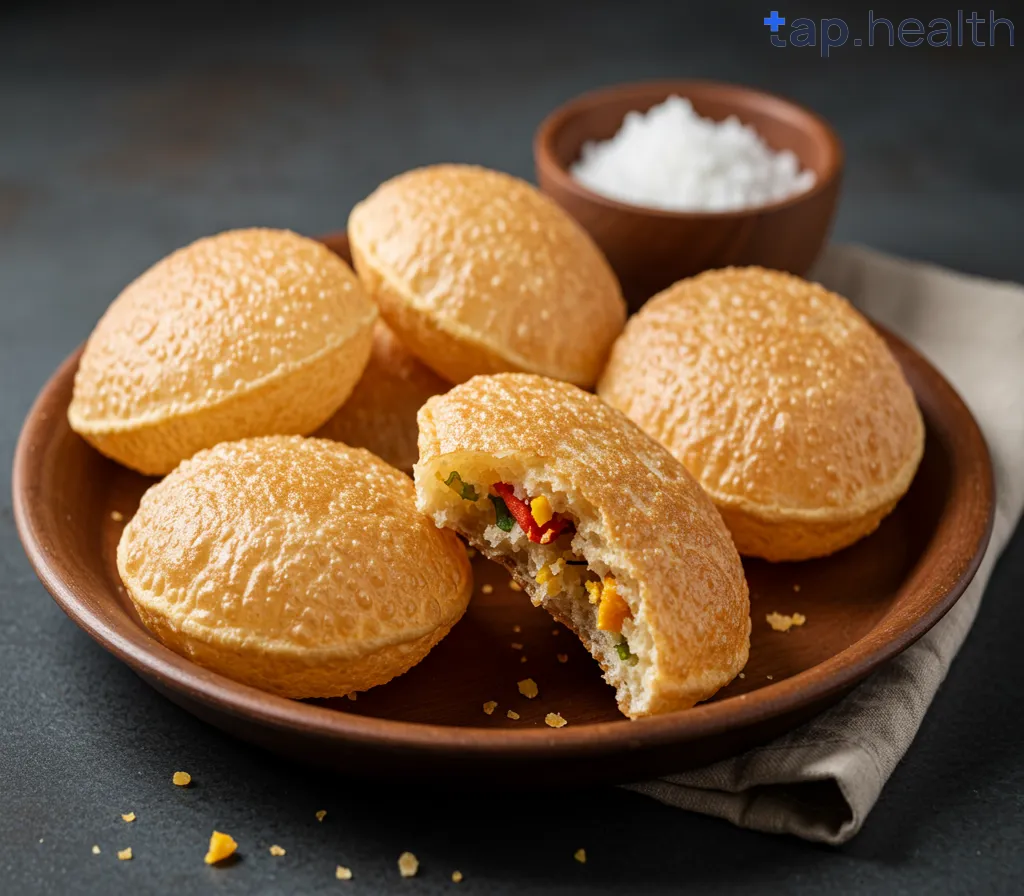Puri is a popular and delicious Indian snack often served during festivals, special occasions, or as part of a hearty meal. Whether you enjoy it with chole (chickpeas), aloo (potato curry), or yogurt, puri is loved by many for its crisp texture and savory flavor. But if you’re curious about how many calories are in puri or looking to make healthier choices, this article will help.
In this post, we’ll break down the calorie content of puri, explore its nutritional value, and provide tips for enjoying this tasty dish without going overboard on calories. So, if you’re a puri fan or just curious about its impact on your diet, let’s dive into the details!
What is Puri?
Puri is a traditional Indian deep-fried bread made from whole wheat flour, salt, and water. The dough is rolled into small, round discs and deep-fried in hot oil or ghee (clarified butter), resulting in a crispy texture. Puri is often served with various accompaniments, such as curry, vegetables, or yogurt.
While puri is enjoyed by many, its calorie content can add up quickly, especially since it’s deep-fried in oil. However, its delicious flavor and satisfying nature make it a popular choice in many Indian households.
How Many Calories are in Puri?
The number of calories in puri depends on the size of the puri, the amount of oil or ghee used for frying, and any accompanying ingredients like curry or chutneys. On average, one puri (approximately 30-40 grams) contains around 150-200 calories.
Basic Puri (Without Accompaniments)
If you’re just eating a simple, plain puri with no toppings or sides, the calorie count will be relatively lower. Here’s the breakdown:
- Calories in one puri: 150–200 calories
This number is based on the assumption that the puri is deep-fried in oil, which contributes a significant portion of the calorie content. The calories are mostly from the flour (carbohydrates) and oil (fat).
Puri with Chole or Aloo
When puri is served with accompaniments like chole (chickpeas) or aloo (potato curry), the calorie content increases. These dishes are often rich in calories due to their high fat or carbohydrate content. A serving of puri with chole or aloo typically contains:
- Calories in one serving (2-3 puris with curry): 400-600 calories
This estimate includes the calories from the puris as well as the curry or chutney served alongside.
Puri with Ghee
Sometimes puri is made with ghee for extra richness. Ghee is a clarified butter that is calorie-dense. If ghee is used for frying or served with puri, it will increase the calorie count. Here’s the breakdown:
- Calories in one puri with ghee: 200–250 calories
Ghee adds additional fat and calories, so using ghee instead of oil can significantly increase the overall calorie content.
Nutritional Breakdown of Puri
While puri is calorie-dense, it also offers some essential nutrients. Let’s take a look at the nutritional breakdown of a standard puri (about 30-40 grams):
- Calories: 150–200 calories (depends on the cooking method and size)
- Carbohydrates: 30–35 grams
- Protein: 3–4 grams
- Fat: 5–8 grams
- Saturated Fat: 1–2 grams (depending on whether ghee or oil is used)
- Fiber: 1–2 grams
- Sodium: 150–250 mg (varies based on salt added to the dough and oil)
- Cholesterol: 5–10 mg (if cooked with ghee or butter)
Puri is primarily a source of carbohydrates, providing energy through its flour base. The fat content, especially if made with ghee or oil, adds richness to the dish but also contributes to the calorie count. Despite being deep-fried, puri provides some protein and small amounts of fiber.
Factors Affecting the Calories in Puri
The calorie content of puri can vary depending on several factors. Here are the key ones:
1. Frying Method
The method used to fry puri plays a crucial role in determining how many calories it contains. If the puri is fried in ghee (clarified butter), it will contain more calories due to the higher fat content of ghee. Similarly, the oil used for frying also adds significant calories.
2. Size of the Puri
The size of the puri directly impacts its calorie count. Larger puris will naturally contain more calories because they use more flour and absorb more oil during frying. If you’re making puri at home, consider making smaller puris to help manage your calorie intake.
3. Accompaniments and Fillings
Puri is often served with curries, chutneys, or yogurt. These accompaniments can significantly affect the overall calorie count. For example, puri with potato curry or chickpea curry will add extra calories, especially if the curry contains a lot of oil or cream. If you’re trying to reduce calorie intake, consider using lighter versions of the side dishes or limiting portion sizes.
4. Type of Flour Used
While traditional puris are made with whole wheat flour, some recipes use refined white flour (maida) to make puris softer and crispier. Puri made with white flour may have a slightly higher glycemic index and less nutritional value compared to whole wheat puri, though the difference in calories may be minimal.
How to Make Puri Healthier
Although puri is a delicious treat, it’s high in calories due to its frying method. If you want to enjoy puri while making it a bit healthier, here are some tips:
1. Use Less Oil or Ghee
The easiest way to reduce the calories in puri is to use less oil or ghee. You can make puri with a smaller amount of oil, or opt for a healthier oil like olive oil. You could also bake the puris instead of deep-frying them to significantly cut down on fat and calories.
2. Choose Whole Wheat Flour
Using whole wheat flour instead of refined white flour will increase the fiber content of the puri and make it a healthier choice. Whole wheat flour also has more nutrients, such as B vitamins, iron, and magnesium.
3. Add More Veggies
To make your puri meal more balanced, add more vegetables to the curry or filling. Vegetables are low in calories and high in vitamins, minerals, and fiber, so they make a great addition to any puri dish. Consider adding spinach, peas, carrots, or cauliflower to your curry for added nutrition.
4. Serve with Lighter Sides
Instead of pairing your puri with a heavy, cream-based curry, consider lighter sides like cucumber raita or a simple tomato chutney. These sides are lower in calories and can help balance out the richness of the puri.
5. Control Portion Sizes
Puri is calorie-dense, so it’s important to be mindful of portion sizes. One or two small puris are usually enough to satisfy your hunger, especially when paired with a nutritious side dish.
Frequently Asked Questions (FAQs) on How Many Calories in Puri? A Complete Guide
1. How many calories are in one puri?
A single puri typically contains around 150–200 calories, depending on the size and whether it’s fried in oil or ghee.
2. Does puri have a lot of fat?
Yes, puri contains a moderate amount of fat, especially if it’s fried in oil or ghee. One puri can have 5–8 grams of fat, with some of it being saturated fat, particularly if ghee is used for frying.
3. Can puri be made with less oil?
Yes, puri can be made with less oil, or even baked, instead of deep-fried. Using less oil or ghee will significantly reduce the calorie content of puri.
4. Is puri a healthy food?
Puri can be part of a healthy diet when eaten in moderation. However, it’s calorie-dense, so it’s best to pair it with lighter, vegetable-based curries and limit oil use for a healthier option.
5. How many calories are in puri with curry?
A serving of puri with curry can contain anywhere from 400-600 calories, depending on the size of the puris and the type of curry served with them.
6. Can I eat puri while on a diet?
You can eat puri while on a diet, but it’s best to do so in moderation. Opt for smaller portions, use less oil, and pair it with healthier sides like vegetable curries or raita.
Conclusion
Puri is a tasty and beloved dish, but it can be calorie-dense due to its frying method and flour base. On average, one puri contains about 150–200 calories, and the calorie count can increase if additional oil, ghee, or rich accompaniments like curries are added. To enjoy puri while keeping your calorie intake in check, consider making smaller portions, using less oil, and pairing it with healthier sides like vegetables or low-fat chutneys. With the right balance, you can enjoy this delicious dish without worrying too much about the calories!


